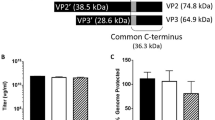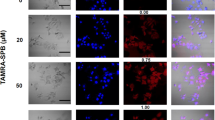Abstract
Most human carcinoma cell lines lack the high-affinity receptors for adenovirus serotype 5 (Ad5) at their surface and are nonpermissive to Ad5. We therefore tested the efficiency of retargeting Ad5 to alternative cellular receptors via immunoglobulin (Ig)-binding domains inserted at the extremity of short-shafted, knobless fibers. The two recombinant Ad5's constructed, Ad5/R7-Zwt-Zwt and Ad5/R7-C2-C2, carried tandem Ig-binding domains from Staphylococcal protein A (abbreviated Zwt) and from Streptococcal protein G (C2), respectively. Both viruses bound their specific Ig isotypes with the expected affinity. They transduced human carcinoma cells independently of the CAR pathway, via cell surface receptors targeted by specific monoclonal antibodies, that is, EGF-R on A549, HT29 and SW1116, HER-2/neu on SK-OV-3 and SK-BR-3, CA242 (epitope recognized by the monoclonal antibody C242) antigen on HT29 and SW1116, and PSMA (prostate-specific membrane antigen) expressed on HEK-293 cells, respectively. However, Colo201 and Colo205 cells were neither transduced by targeting CA242 or EGF-R nor were LNCaP cells transduced by targeting PSMA. Our results suggested that one given surface receptor could mediate transduction of certain cells but not others, indicating that factors and steps other than cell surface expression and virus–receptor interaction are additional determinants of Ad5-mediated transduction of tumor cells. Using penton base RGD mutants, we found that one of these limiting steps was virus endocytosis.
This is a preview of subscription content, access via your institution
Access options
Subscribe to this journal
Receive 12 print issues and online access
$259.00 per year
only $21.58 per issue
Buy this article
- Purchase on Springer Link
- Instant access to full article PDF
Prices may be subject to local taxes which are calculated during checkout












Similar content being viewed by others
References
Russell WC . Update on adenovirus and its vectors. J Gen Virol 2000; 81: 2573–2604.
Krasnykh VN, Douglas JT, van Beusechem VW . Genetic targeting of adenoviral vectors. Mol Ther 2000; 1: 391–405.
Bergelson JM et al. Isolation of a common receptor for Coxsackie B viruses and adenoviruses 2 and 5. Science 1997; 275: 1320–1323.
Hong SS et al. Adenovirus type 5 fiber knob binds to MHC class I alpha2 domain at the surface of human epithelial and B lymphoblastoid cells. EMBO J 1997; 16: 2294–2306.
Wickham TJ, Mathias P, Cheresh DA, Nemerow GR . Integrins alpha v beta 3 and alpha v beta 5 promote adenovirus internalization but not virus attachment. Cell 1993; 73: 309–319.
Dechecchi MC, Tamanini A, Bonizzato A, Cabrini G . Heparan sulfate glycosaminoglycans are involved in adenovirus type 5 and 2–host cell interactions. Virology 2000; 268: 382–390.
Tomko RP, Xu R, Philipson L . HCAR and MCAR: the human and mouse cellular receptors for subgroup C adenoviruses and group B coxsackieviruses. Proc Natl Acad Sci USA 1997; 94: 3352–3356.
Hong SS et al. Enhancement of adenovirus-mediated gene delivery by use of an oligopeptide with dual binding specificity. Hum Gene Ther 1999; 10: 2577–2586.
Wickham TJ et al. Targeted adenovirus-mediated gene delivery to T cells via CD3. J Virol 1997; 71: 7663–7669.
van Beusechem VW et al. Efficient and selective gene transfer into primary human brain tumors by using single-chain antibody-targeted adenoviral vectors with native tropism abolished. J Virol 2002; 76: 2753–2762.
Soudais C et al. Canine adenovirus type 2 attachment and internalization: coxsackievirus-adenovirus receptor, alternative receptors, and an RGD-independent pathway. J Virol 2000; 74: 10639–10649.
Magnusson MK, Hong SS, Boulanger P, Lindholm L . Genetic retargeting of adenovirus: novel strategy employing ‘deknobbing’ of the fiber. J Virol 2001; 75: 7280–7289.
Henning P et al. Genetic modification of adenovirus 5 tropism by a novel class of ligands based on a three-helix bundle scaffold derived from staphylococcal protein A. Hum Gene Ther 2002; 13: 1427–1439.
Magnusson MK et al. Genetic retargeting of adenovirus vectors: functionality of targeting ligands and their influence on virus viability. J Gene Med 2002; 4: 356–370.
Nilsson B et al. A synthetic IgG-binding domain based on staphylococcal protein A. Protein Eng 1987; 1: 107–113.
Nord K et al. A combinatorial library of an alpha-helical bacterial receptor domain. Protein Eng 1995; 8: 601–608.
Eliasson M et al. Differential IgG-binding characteristics of staphylococcal protein A, streptococcal protein G, and a chimeric protein AG. J Immunol 1989; 142: 575–581.
Harlow E, Lane D . Reagents. In: Harlow E, Lane D (ed). Antibodies, A Laboratory Manual. Cold Spring Harbor Laboratory: New York, 1988, pp 613–633.
Nagaoka M, Akaike T . Single amino acid substitution in the mouse IgG1 Fc region induces drastic enhancement of the affinity to protein A. Protein Eng 2003; 16: 243–245.
Ciardiello F, Tortora G . A novel approach in the treatment of cancer: targeting the epidermal growth factor receptor. Clin Cancer Res 2001; 7: 2958–2970.
Sridhar SS, Seymour L, Shepherd FA . Inhibitors of epidermal-growth-factor receptors: a review of clinical research with a focus on non-small-cell lung cancer. Lancet Oncol 2003; 4: 397–406.
Curnow RT . Clinical experience with CD64-directed immunotherapy. An overview. Cancer Immunol Immunother 1997; 45: 210–215.
Volpers C et al. Antibody-mediated targeting of an adenovirus vector modified to contain a synthetic immunoglobulin G-binding domain in the capsid. J Virol 2003; 77: 2093–2104.
Hung MC, Lau YK . Basic science of HER-2/neu: a review. Semin Oncol 1999; 26: 51–59.
Baselga J et al. Phase II study of weekly intravenous recombinant humanized anti-p185HER2 monoclonal antibody in patients with HER2/neu-overexpressing metastatic breast cancer. J Clin Oncol 1996; 14: 737–744.
Molina MA et al. Trastuzumab (herceptin), a humanized anti-Her2 receptor monoclonal antibody, inhibits basal and activated Her2 ectodomain cleavage in breast cancer cells. Cancer Res 2001; 61: 4744–4749.
Kashentseva EA, Seki T, Curiel DT, Dmitriev IP . Adenovirus targeting to c-erbB-2 oncoprotein by single-chain antibody fused to trimeric form of adenovirus receptor ectodomain. Cancer Res 2002; 62: 609–616.
Baeckstrom D et al. Discrimination of MUC1 mucins from other sialyl-Le(a)-carrying glycoproteins produced by colon carcinoma cells using a novel monoclonal antibody. Cancer Res 1993; 53: 755–761.
Johansson C et al. Novel epitopes on the CA50-carrying antigen: chemical and immunochemical studies. Tumour Biol 1991; 12: 159–170.
Debinski W, Pastan I . Recombinant F(ab′) C242-Pseudomonas exotoxin, but not the whole antibody-based immunotoxin, causes regression of a human colorectal tumor xenograft. Clin Cancer Res 1995; 1: 1015–1022.
Calvete JA, Newell DR, Wright AF, Rose MS . In vitro and in vivo antitumor activity of ZENECA ZD0490, a recombinant ricin A-chain immunotoxin for the treatment of colorectal cancer. Cancer Res 1994; 54: 4684–4690.
Chang SS et al. Five different anti-prostate-specific membrane antigen (PSMA) antibodies confirm PSMA expression in tumor-associated neovasculature. Cancer Res 1999; 59: 3192–3198.
Fracasso G et al. Anti-tumor effects of toxins targeted to the prostate specific membrane antigen. Prostate 2002; 53: 9–23.
Smith-Jones PM et al. Radiolabeled monoclonal antibodies specific to the extracellular domain of prostate-specific membrane antigen: preclinical studies in nude mice bearing LNCaP human prostate tumor. J Nucl Med 2003; 44: 610–617.
Trainer DL et al. Biological characterization and oncogene expression in human colorectal carcinoma cell lines. Int J Cancer 1988; 41: 287–296.
Wickham TJ et al. Increased in vitro and in vivo gene transfer by adenovirus vectors containing chimeric fiber proteins. J Virol 1997; 71: 8221–8229.
Krasnykh V et al. Genetic targeting of an adenovirus vector via replacement of the fiber protein with the phage T4 fibritin. J Virol 2001; 75: 4176–4183.
van Beusechem VW et al. Conditionally replicative adenovirus expressing a targeting adapter molecule exhibits enhanced oncolytic potency on CAR-deficient tumors. Gene Therapy 2003; 10: 1982–1991.
Jongmans W et al. Targeting of adenovirus to human renal cell carcinoma cells. Urology 2003; 62: 559–565.
Barker SD et al. Combined transcriptional and transductional targeting improves the specificity and efficacy of adenoviral gene delivery to ovarian carcinoma. Gene Therapy 2003; 10: 1198–1204.
Blackwell JL et al. Retargeting to EGFR enhances adenovirus infection efficiency of squamous cell carcinoma. Arch Otolaryngol Head Neck Surg 1999; 125: 856–863.
Meier O, Greber UF . Adenovirus endocytosis. J Gene Med 2003; 5: 451–462.
Medina-Kauwe LK . Endocytosis of adenovirus and adenovirus capsid proteins. Adv Drug Deliv Rev 2003; 55: 1485–1496.
Chroboczek J, Gout E, Favier AL, Galinier R . Novel partner proteins of adenovirus penton. Curr Top Microbiol Immunol 2003; 272: 37–55.
Miyazawa N, Crystal RG, Leopold PL . Adenovirus serotype 7 retention in a late endosomal compartment prior to cytosol escape is modulated by fiber protein. J Virol 2001; 75: 1387–1400.
Jendeberg L et al. Engineering of Fc(1) and Fc(3) from human immunoglobulin G to analyse subclass specificity for staphylococcal protein A. J Immunol Methods 1997; 201: 25–34.
Hong JS, Engler JA . The amino terminus of the adenovirus fiber protein encodes the nuclear localization signal. Virology 1991; 185: 758–767.
Gülich S, Linhult M, Stahl S, Hober S . Engineering streptococcal protein G for increased alkaline stability. Protein Eng 2002; 15: 835–842.
Karayan L et al. Structural and functional determinants in adenovirus type 2 penton base recombinant protein. J Virol 1997; 71: 8678–8689.
Neumann R, Chroboczek J, Jacrot B . Determination of the nucleotide sequence for the penton-base gene of human adenovirus type 5. Gene 1988; 69: 153–157.
O’Reilly DR, Miller LK, Luckow VA . Virus Methods. In: Press OU (ed) Baculovirus Expression Vectors. A Laboratory Manual. Oxford, England, 1994, pp 124–138.
Mittereder N, March KL, Trapnell BC . Evaluation of the concentration and bioactivity of adenovirus vectors for gene therapy. J Virol 1996; 70: 7498–7509.
Acknowledgements
We are grateful to Simone Peyrol and Christel Mathias (Centre Commun d’Imagerie, Faculté de Médecine Laennec) for their help in electron microscopy. We acknowledge the Swegene Centre of Cellular Imaging at Gothenburg University for the use of imaging equipment. This work was financially supported by grants from Got-a-Gene AB, Stena Center, Gothenburg, Sweden, from the Association Françai'se contre les Myopathies (AFM), Institut de Myologie, Paris (Subvention AFM/Groupe E/2003/11845-9481), and from the Association Vaincre la Mucoviscidose (VLM), Paris, France.
Author information
Authors and Affiliations
Rights and permissions
About this article
Cite this article
Henning, P., Andersson, K., Frykholm, K. et al. Tumor cell targeted gene delivery by adenovirus 5 vectors carrying knobless fibers with antibody-binding domains. Gene Ther 12, 211–224 (2005). https://doi.org/10.1038/sj.gt.3302408
Received:
Accepted:
Published:
Issue Date:
DOI: https://doi.org/10.1038/sj.gt.3302408
Keywords
This article is cited by
-
Desmoglein 2 (DSG2) Is A Receptor of Human Adenovirus Type 55 Causing Adult Severe Community-Acquired Pneumonia
Virologica Sinica (2021)
-
Engineered adenovirus fiber shaft fusion homotrimer of soluble TRAIL with enhanced stability and antitumor activity
Cell Death & Disease (2016)
-
Overcoming tumor resistance by heterologous adeno-poxvirus combination therapy
Molecular Therapy - Oncolytics (2014)
-
The Effect of Fiber Truncations on the Stability of Adenovirus Type 5
Molecular Biotechnology (2014)
-
Toxicity of Fiber- and Penton Base–modified Adenovirus Type 5 Vectors on Lung Development in Newborn Rats
Molecular Therapy (2007)



